The Immunoturbidimetric Kits Market is estimated to be valued at USD 1.2 billion in 2025 and is projected to reach USD 1.9 billion by 2035, registering a compound annual growth rate (CAGR) of 4.8% over the forecast period.
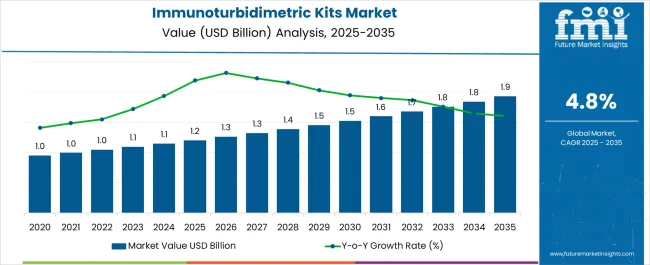
| Metric | Value |
|---|---|
| Immunoturbidimetric Kits Market Estimated Value in (2025 E) | USD 1.2 billion |
| Immunoturbidimetric Kits Market Forecast Value in (2035 F) | USD 1.9 billion |
| Forecast CAGR (2025 to 2035) | 4.8% |
The immunoturbidimetric kits market is expanding steadily due to the rising prevalence of chronic diseases, increasing adoption of automated diagnostic platforms, and demand for cost effective yet reliable testing solutions. These kits are widely used in clinical laboratories and hospitals for the quantitative determination of proteins, enzymes, and other analytes critical in disease diagnosis and monitoring.
Advancements in assay sensitivity, coupled with compatibility with high throughput analyzers, have reinforced their role in modern diagnostics. The growing shift toward early disease detection and preventive healthcare strategies is further driving demand.
Regulatory emphasis on diagnostic accuracy and efficiency is encouraging laboratories to integrate advanced immunoturbidimetric kits. The market outlook remains positive as ongoing innovation in assay design and automated platforms continues to enhance performance, scalability, and accessibility in diverse healthcare settings.
The reagent kits segment is expected to account for 38.60% of the total revenue by 2025 within the product category, establishing itself as a leading sub segment. Growth in this segment is driven by the rising need for standardized, ready to use solutions that reduce variability and improve reliability in laboratory testing.
Their compatibility with automated analyzers and ability to provide consistent performance have supported their widespread adoption.
In addition, the scalability of reagent kits allows laboratories to manage both routine and specialized testing efficiently, reinforcing their market leadership.
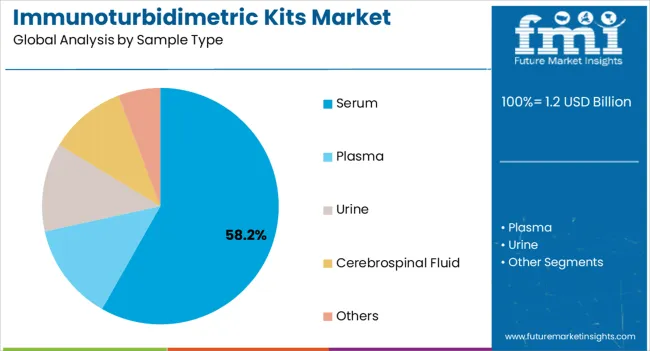
The serum sample type segment is projected to hold 58.20% of total revenue by 2025, making it the most significant sample type category. Serum remains the preferred matrix for immunoturbidimetric testing due to its stability, accuracy, and ability to provide clear insights into protein and biomarker levels.
Widespread clinical reliance on serum samples for diagnostic applications has further strengthened this segment.
Its compatibility with high throughput analyzers and suitability for large scale testing environments continue to underpin its dominance.
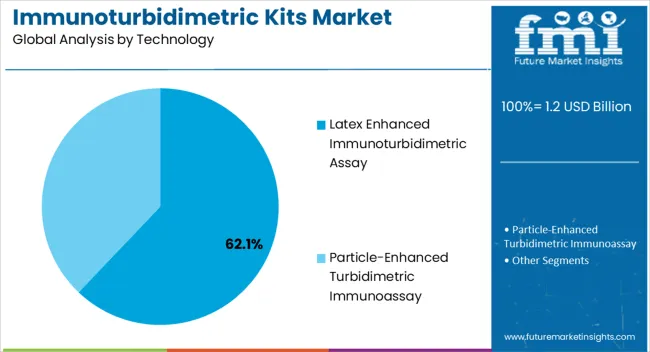
The latex enhanced immunoturbidimetric assay technology segment is anticipated to represent 62.10% of market revenue by 2025, positioning it as the most dominant technology. This is attributed to its high sensitivity, rapid turnaround time, and ability to detect low concentrations of analytes with enhanced precision.
The technique’s efficiency in handling a wide range of biomarkers and compatibility with automated systems have further driven adoption.
Continuous improvements in latex particle technology have contributed to improved assay performance, ensuring this technology remains central to the immunoturbidimetric kits market.
From 2012 to 2025, the global immunoturbidimetric kits market experienced a CAGR of 2.5%, reaching a market size of USD 1.2 billion in 2025.
From 2012 to 2025, Over time, the market for immunoturbidimetric kits has grown consistently. Immunoturbidimetric assays are increasingly being used to measure a variety of biomarkers due to its versatility, simplicity, and accuracy. Standardized, ready-to-use immunoturbidimetric kits have emerged on the market, increasing the effectiveness and dependability of testing.
Future Forecast for Immunoturbidimetric Kits Industry:
Looking ahead, the global immunoturbidimetric kits industry is expected to rise at a CAGR of 5.1% from 2025 to 2035. During the forecast period, the market size is expected to reach USD 1.90 billion by 2035.
In the upcoming years, the market for immunoturbidimetric kits is anticipated to maintain its upward trend. The prevalence of infectious and chronic diseases is rising, and early disease diagnosis is becoming increasingly important. These and other factors are projected to fuel market growth.
The market is anticipated to profit from continuous technological developments, such as enhanced multiplexing and detecting systems. These developments will increase the immunoturbidimetric assays' sensitivity, specificity, and adaptability, extending the range of diseases and research sectors for which they can be used.
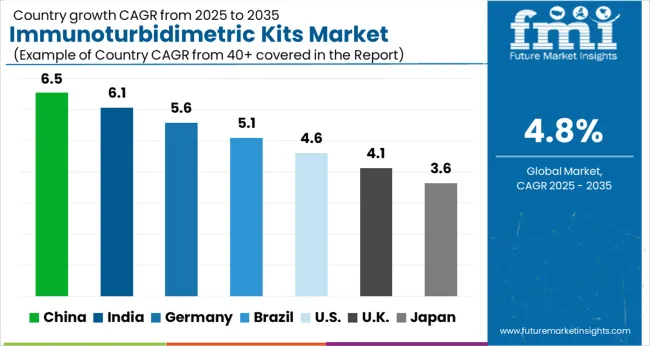
| Country | The United States |
|---|---|
| Market Size (USD million) by End of Forecast Period (2035) | USD 1.9 million |
| CAGR % 2025 to End of Forecast (2035) | 6.4% |
The immunoturbidimetric kits industry in the United States is expected to reach a market size of USD 1.9 million by 2035, expanding at a CAGR of 6.4%. The USA healthcare system is increasingly adopting automated laboratory systems to improve efficiency, reduce errors, and streamline workflow.
Immunoturbidimetric kits are compatible with automated platforms, allowing for high-throughput testing and integration with laboratory information systems (LIS). The adoption of automated systems in clinical laboratories drives the demand for immunoturbidimetric kits, contributing to market growth.
| Country | The United Kingdom |
|---|---|
| Market Size (USD million) by End of Forecast Period (2035) | USD 58.7 million |
| CAGR % 2025 to End of Forecast (2035) | 4.9% |
The immunoturbidimetric kits industry in the United Kingdom is expected to reach a market value of USD 58.7 million, expanding at a CAGR of 4.9% during the forecast period. The UK is known for its advancements in medical technology and diagnostic assays.
The development and adoption of advanced immunoturbidimetric assays, improved reagents, automated platforms, and enhanced detection systems contribute to the growth of the Immunoturbidimetric Kits market. Technological advancements improve the accuracy, sensitivity, and speed of testing, making immunoturbidimetric kits a preferred choice for diagnostic laboratories and healthcare providers in the UK
| Country | China |
|---|---|
| Market Size (USD million) by End of Forecast Period (2035) | USD 215.9 million |
| CAGR % 2025 to End of Forecast (2035) | 7.9% |
The immunoturbidimetric kits industry in China is anticipated to reach a market size of USD 215.9 million, moving at a CAGR of 7.9% during the forecast period. There is an increasing emphasis on preventive healthcare in China, with a focus on early disease detection and management.
Immunoturbidimetric kits play a vital role in preventive health check-ups and screening programs by providing rapid and accurate results for a wide range of biomarkers. The implementation of preventive healthcare initiatives by the Chinese government and healthcare organizations drives the demand for immunoturbidimetric kits.
| Country | Japan |
|---|---|
| Market Size (USD million) by End of Forecast Period (2035) | USD 81.1 million |
| CAGR % 2025 to End of Forecast (2035) | 6.6% |
The immunoturbidimetric kits industry in Japan is estimated to reach a market size of USD 81.1 million by 2035, thriving at a CAGR of 6.6%. The Japanese government emphasizes preventive healthcare and encourages regular health check-ups for early disease detection and management.
Immunoturbidimetric kits play a vital role in preventive health screenings by providing rapid and accurate results for a wide range of biomarkers. The implementation of preventive healthcare programs and initiatives by the Japanese government and healthcare organizations drives the demand for immunoturbidimetric kits.
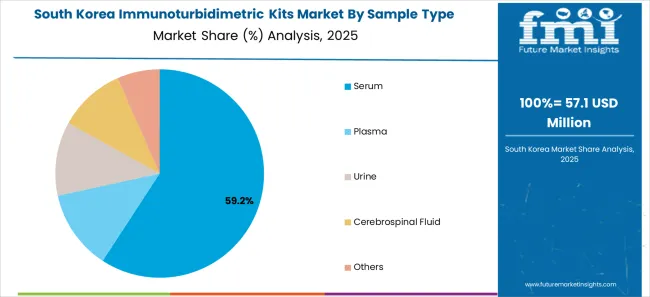
| Country | South Korea |
|---|---|
| Market Size (USD million) by End of Forecast Period (2035) | USD 53.4 million |
| CAGR % 2025 to End of Forecast (2035) | 5.7% |
The immunoturbidimetric kits industry in South Korea is expected to reach a market size of USD 53.4 million, expanding at a CAGR of 5.7% during the forecast period. South Korean government supports healthcare innovation and has implemented initiatives to promote the development and adoption of advanced diagnostic technologies.
These initiatives include funding research projects, supporting collaborations between academia and industry, and providing regulatory guidelines for the approval and commercialization of immunoturbidimetric kits. Government support contributes to the growth of the Immunoturbidimetric Kits market in South Korea.
Reagent kits is expected to dominate the immunoturbidimetric kits industry with a CAGR of 5.8% from 2025 to 2035. Reagent kits provide pre-optimized and standardized chemicals, removing the need for lab technicians to make reagents from scratch. This shortens the testing procedure, lowers the likelihood of mistakes, and saves time in the lab.
Reagent kits are produced using stringent quality control procedures to guarantee reliable performance. The accuracy of measurements is improved and variability is reduced when standardized reagents are used, which is essential in clinical diagnostics.
The Serum sample is expected to dominate the immunoturbidimetric kits industry with a CAGR of 6.5% from 2025 to 2035. Serum contains a wide range of biomarkers, including proteins, enzymes, hormones, lipids, and other analytes. These biomarkers provide valuable information about various diseases, organ function, and overall health status.
Immunoturbidimetric assays performed on serum samples enable the quantitative measurement of these biomarkers, facilitating disease diagnosis, prognosis, and treatment monitoring. The clinical relevance of serum biomarkers drives the demand for immunoturbidimetric kits.
Latex enhanced immunoturbidimetric assay is expected to dominate the immunoturbidimetric kits industry with a CAGR of 4.7% from 2025 to 2035. Latex-enhanced immunoturbidimetric assays offer improved sensitivity compared to conventional immunoturbidimetry.
The use of latex particles coated with antibodies or antigens increases the surface area available for the binding of analytes, resulting in enhanced detection capabilities. This increased sensitivity allows for the measurement of analytes at lower concentrations, expanding the range of applications and driving the demand for immunoturbidimetric kits.
The Infectious disease are expected to dominate the immunoturbidimetric kits industry with a CAGR of 4.3% from 2025 to 2035. The rise of infectious diseases has increased the need for precise and effective diagnostic methods. Infectious diseases are a major problem for global health.
Antigens, antibodies, and pathogen-specific proteins are among the infectious illness indicators that can be accurately and quantitatively measured using immunoturbidimetric techniques. The market has grown as a result of the widespread use of immunoturbidimetric kits in clinical laboratories and healthcare facilities to identify and track infectious illnesses.
The hospital segment is expected to dominate the immunoturbidimetric kits industry with a CAGR of 6.2% from 2025 to 2035. Hospitals typically handle a large volume of patient samples on a daily basis. Immunoturbidimetric assays, which are widely used in clinical laboratories, offer a reliable and efficient method for quantitatively measuring various analytes in patient samples. The high testing volume in hospitals has contributed to the increased adoption of immunoturbidimetric kits, supporting the growth of the market.
The global immunoturbidimetric kits market is estimated to be valued at USD 1.2 billion in 2025.
The market size for the immunoturbidimetric kits market is projected to reach USD 1.9 billion by 2035.
The immunoturbidimetric kits market is expected to grow at a 4.8% CAGR between 2025 and 2035.
The key product types in immunoturbidimetric kits market are reagent kits, _albumin test, _microglobulin albumin test, _c-reactive protein test, _fibrinogen test, _fibronectin test, _haptoglobin test, _kappa light chains, _lambda light chains, _transferrin test, _alpha-1-acid glycoprotein test, _alpha-1-antitrypsin test, _apolipoprotein b test, _cystatin test, _ferritin test, _immunoglobulin test, _lipoprotein test, _others and controls kits/reagents.
In terms of sample type, serum segment to command 58.2% share in the immunoturbidimetric kits market in 2025.






Full Research Suite comprises of:
Market outlook & trends analysis
Interviews & case studies
Strategic recommendations
Vendor profiles & capabilities analysis
5-year forecasts
8 regions and 60+ country-level data splits
Market segment data splits
12 months of continuous data updates
DELIVERED AS:
PDF EXCEL ONLINE
Hip Kits Market Size and Share Forecast Outlook 2025 to 2035
Oiler Kits Market Size and Share Forecast Outlook 2025 to 2035
Audio Kits Market
RT-PCR Kits Market Growth - Trends & Forecast 2023 to 2035
Lavage Kits Market
Organoids Kits Market
Connector Kits Market
Capacitor Kits Market
Extraction Kits Market Analysis - Size, Share, and Forecast Outlook 2025 to 2035
DIY Haircut Kits Market - Trends, Growth & Forecast 2025 to 2035
EMI, Filter Kits Market
Nephelometry Kits Market Size and Share Forecast Outlook 2025 to 2035
Analysis and Growth Projections for Chilled Meal Kits Market
1-Step RT-PCR Kits Market Size and Share Forecast Outlook 2025 to 2035
Demining Tool Kits Market Size and Share Forecast Outlook 2025 to 2035
Antibody Pair Kits Market
Skin Traction Kits Market
Flu Protection Kits Market Size and Share Forecast Outlook 2025 to 2035
Guided Surgery Kits Market Size, Growth, and Forecast for 2025 to 2035
Fungal Testing Kits Market Analysis – Size, Trends & Forecast 2025 to 2035

Thank you!
You will receive an email from our Business Development Manager. Please be sure to check your SPAM/JUNK folder too.
Chat With
MaRIA